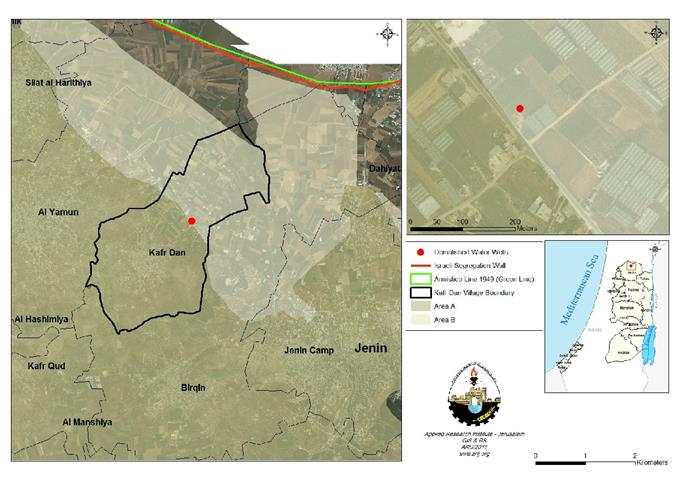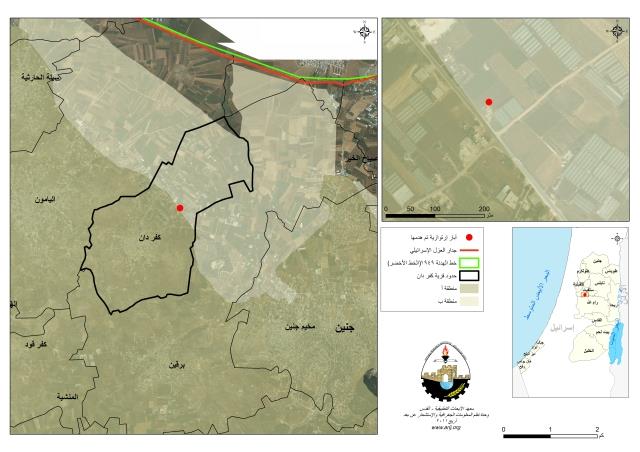On May 29, 2011, the Israeli Occupation Authorities and army, accompanied by the Israeli Water Authority, demolished eight agricultural water wells and destroyed logistics in the village of Kofer-Dan, located north of the West Bank in the Jenin district. This is the second time that the Israeli Authorities demolished these wells, the first of which occurred on March 1, 2011 when the authorities raided the village and razed five agricultural water wells. The water wells that were demolished are located in the plain area of the village, which supplies the largest share of economic and nutritional income for the village.
Each demolition was held at a period where the Palestinian farmers were beginning to gather produce during the harvesting period; the demolition of wells inhibits Palestinian farmers from experiencing positive agricultural results; high shares of water is demanded in order for plants to thrive. Therefore, to appropriate access to water supply sources is to impede Palestinian farmers on both an economic level and a food source supply level from achieving their highest crop ratio. For the simple Palestinian farmer, these limitations could sever the growth of crops, lead to lack of food sources, and inevitably bring about an economic crisis.
Kofor –Dan village is considered one of the largest food baskets for the Jenin District, where 25% of its crops are directed to fulfill the nutritional demand. These demolitions severely penetrate the agricultural heart of the Jenin District, the heart of Kofor-Dan, by taking away the source that provides these communities with ¼ of its food.
Furthermore, in order to build a barrier, in order to suffocate the Palestinian farmer from producing agricultural results, the Israeli Authorities have refused to give renovation licenses for the six artesian water wells that were built during the Jordanian mandate. These wells encompass 2,000,000 Cubic Meters in total; however, due to the Israeli policies in that area, none of these water wells are allowed to be used or consumed. As a result, the Palestinian farmers began to independently dig agricultural water wells, reaching a total number of 150 agricultural water wells.
This has resulted in a critical, sensitive situation where Israeli authorities refuse to provide permits to re-build or renovate the six large artesian water wells of Kofor-Dan village, and where Palestinian farmers are forced to maintain construction and upkeep of wells without licensing in order to keep their main source of income and agricultural industry alive.
Village requests for stronger water supply infrastructure within the community has been rejected by the Israeli Authorities; 60% of Kofor – Dan Village houses are consequently lacking water supply infrastructural networks. Such re-construction of agricultural water wells after demolition requires at least 5000 US dollars to rehabilitate. Moreover, after the demolition, the water directed to these wells will be rare and cost a lot because it will have to be bought from outside sources, costing approximately 4.02 NIS / Cubic Meters. Even more so, these wells form the main source of life not only for the farmers, but for the surrounding communities; these 150 agricultural wells form in total about 1,700,000 Cubic Meters and supply the needs of the village. Table 01 shows the damages and casualties generated by the Israeli demolition attacks in Kofor–Dan Village, within the Jenin District. Map 01 shows the demolished wells in Kofor – Dan Village, within the Jenin District in the Northern West Bank.
|
Table 01: Damages and casualties generated by the Israeli demolition attacks in Kofor–Dan Village, in Jenin District
|
|
No.
|
NAME
|
Total Costs (in NIS)
|
Irrigated area (in Dunums)
|
# of Users
|
|
01.
|
Ahmad Muhammad Jabareen
|
18715 NIS
|
20
|
40
|
|
02.
|
Subhi Muhammad Mar’i
|
18420 NIS
|
20
|
40
|
|
03.
|
Muhammad Mahfouz Mar’i
|
15265 NIS
|
40
|
80
|
|
04.
|
Baha’ Muhammad Mar’i
|
18715 NIS
|
30
|
60
|
|
05.
|
Mustafa Ahmad A’bed
|
19320 NIS
|
70
|
120
|
|
06.
|
Muhammad Sa’id Sa’adih
|
12440 NIS
|
6
|
20
|
|
07.
|
Subhi Ahmad A’bed
|
20560 NIS
|
60
|
150
|
|
08.
|
Mahmoud Saleh A’bed
|
23000 NIS
|
100
|
200
|
|
09.
|
Total
|
146435 NIS
|
346 Dunums
|
710 People
|
|
Source: Kofor–Dan Local Village Council / 2011
|
The results were acquired by the field team work of ARIJ who met the Chairman and the Vice Chairman of Kofor–Dan village. Both of the officials took the field team to the site, showed them the demolished wells, and arranged question sessions with locals there who provided a brief history about the Israeli Assaults on the water wells in Kofor–Dan village. Image 01, Image 02, and Image 03 shows one of the eight agricultural wells that have been demolished. These images also reveal how the horsepipes were cut, and how, just in front of the horsepipes, the wells were piled with soil and stones by the Israeli Occupation Dozers.
Map 01: The demolished wells in Kofor – Dan Village, Jenin District, in Northern West Bank
Source: GIS unit 2011 / ARIJ
Image 1 Image 2 Image 3
It is worth mentioning that the Israeli Occupation Authorities, Army, and Israel Water Authority claimed that the wells were demolished because they are not following specific conditions, and form some threat to the state of Israel. Some of the pretexts for this argument were the randomization of building these wells; the second was not acquiring the building licenses for these wells. As for the claimed threat, Israel Water Authority asserted that these wells have driven down the level of Israel’s water, which should be provided for Israeli settlers and citizens. The Israeli Authorities have demolished, controlled, and stolen water from a Palestinian area, where Kofor–Dan Village is classified as AREA B which falls under Palestinian custody and control. The resources that are located within the land must benefit the Palestinian people, not controlled and stolen as to be easily offered for Israeli settlers!
Kofor–Dan Village:
Kofor–Dan is a Palestinian village in the West Bank, located in the northwest of Jenin city, with a distance of 8 km. According to the Palestinian Central Bureau of Statistics, Kofor–Dan Village reached a population of 6,993 inhabitants in the year of 2010, Kofor–Dan village has a total area of 7383.31 dunums; 525.6 dunums of which contain the built-up area of the village. From the south it is surrounded by Burkin Village, and from the west the village of Yamoun.
Conclusion
The Israeli Occupation Authorities, Occupation Army, and Israel Water’s authority barefacedly steels life resources of the Palestinians, and, without respect, breaks international community laws, rules, and conventions. With such actions, Israel aims to cleanse the Palestinian people, and remove them from their land once again; this time, not with genocides and massacres as it did in 1948 and 1967, but cleansing them by suffocating their life income and access to food. This results in Palestinian farmers feeling forced to learn another craft, rather than continue farming their agricultural land, and left immigrating from their houses in search for better jobs that can offer food and a better life for their families
Such actions have been planned for a long time, when the unique identity and connection between the land and the Palestinian people is cut; this connection makes it easier to drive the Palestinians out of their lands. A well schemed, well plotted, demonic project for evacuating and excavating Palestinians from their land with cold nerve has been happening again and again. No one is attempting to stop these instances of ethnic cleansing, genocide, and massacre; all that Palestinians hear from the outside world is to embrace the “Silence of the Lambs.” As for the broken law and conventions, are the different articles of Geneva’s 4th Convention, Human Rights Declaration, and others:
- Universal Declaration of Human Rights, the 10th of December 1948, General Assembly Resolution 217/A/III, Article 17 stated: ‘No one shall be arbitrarily deprived of his property.’ Which means it bans Israel from destroying or confiscating the property of the Palestinians at any case’.
- The Hague Convention 1907, Article 23 stated: ‘In addition to the prohibitions provided by special Conventions, it is especially forbidden to destroy or seize the enemy’s property, unless such destruction or seizure would be imperatively demanded by the necessities of war’.
- Geneva’s 4th Convention, Article 147 stated: ‘Extensive destruction and appropriation of property not justified by military necessity and carried out unlawfully and wantonly, is a grave breach of the Convention’.
- Paris Protocols of 1954 states: ‘Free access for Palestinian goods to the Israeli market and vice versa. The curfews and the uprooting are a clear violation of this clear security’.

















